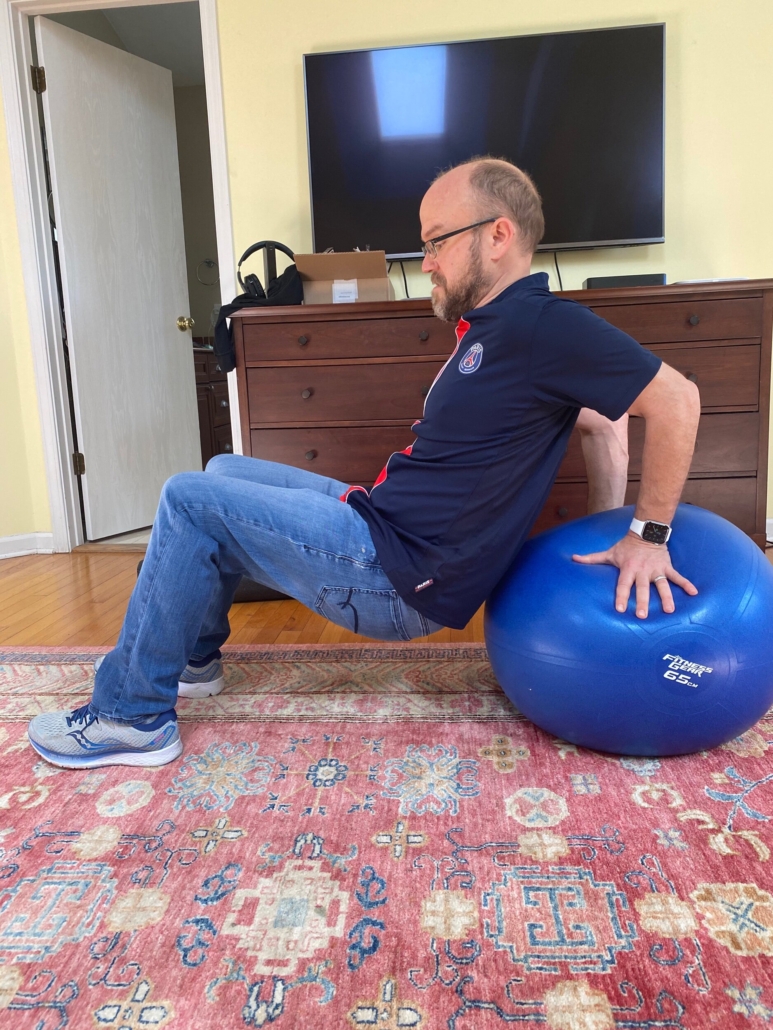Home Gyms
You have everything you need in your home to train today. Space and lack of equipment do not need to be obstacles.

Clients are making use of available space to train.
What do I need to start training in my home?
Location: Find a space approximately 6‘ x 4‘. Halls work well. In front of a sofa, beside a bed, or next to a desk are good options. If there is room for you to walk, there is room for you to train.
Video Chat: If you are going to be training via video chat and want feedback, have a 6’ x 4’ space visible to the camera. When you reach for the ceiling, you should be seen from your toes to the top of your hands.
Equipment: Consider adding a yoga mat, chair, and wall.
Low Impact Cardio Training: Marching, alternating kickbacks (heel to butt), alternating side steps, and climbing stairs are all great options for low impact cardio.
High Impact Cardio Training: High knees, skipping, jogging in place, jumping jacks, jumping rope, and running stairs work well for high impact cardio. Remember for high impact training, start off slow and build over time. When you are beginning, consider five minutes total of the high impact exercise broken into one-minute increments followed by two or more low impact minutes.
Strength Training: All body weight strength exercises work well in small spaces. Your muscles can not tell the difference between kettlebells, dumbbells, and your own body used as weight. Squats, lunges, pushups, and dips are excellent body weight movements. A chair can be used to make many exercises more or less intense. For example, a pushup with your hands on the seat of the chair is less intense than a pushup with your feet on the seat of the chair.
 Raising your feet will make planks, mountain climbers, pushups, pike presses, and most body weight exercises more challenging.
Raising your feet will make planks, mountain climbers, pushups, pike presses, and most body weight exercises more challenging.
Core Training: Core strengthening exercises are easily completed in small spaces and are often done on a mat. Shoulder bridges and deadbugs are two favorites.
 Stabilizing becomes more challenging when a shoulder bridge is completed on one leg.
Stabilizing becomes more challenging when a shoulder bridge is completed on one leg.
Mobility Training: Working to improve mobility can be done in many different positions including, standing, sitting, crouching, and lying down.
What else could I use in my home?
A home is filled with functional training equipment.
Strength Training: Anything you can lift in your home can be utilized during strength training. Squat while lifting an ottoman. Farmer’s carry two folding chairs. Hinge row a shopping bag filled with canned goods. Swing a frying pan. Shoulder raise a casserole dish. The opportunities are endless.

A cast iron casserole dish is being held overhead during a deep squat.
Stability Training: Cushions can be used like a Bosu. Stand with either one or both feet on the cushion. Squats, lunges, single leg deadlifts, split squats, split kneels, and single leg stands all become a stability challenge when you add a cushion. Another home stability challenge option is using socks to slide your feet or hands. Sliding lunges, sliding hands out and in, and jackknifes are all excellent stability exercises that can be done with socks sliding on a smooth surface.
What equipment should I invest in?
Bands: Relatively inexpensive, space saving and versatile, exercise bands are a good investment. Use the bands to add resistance to your workout. Exercises can be completed with greater or less resistance by adjusting the tension in the band.

Three types of bands are show here. The band on the left does not have a loop. The middle band is a large loop band, and the band on the right is a small loop band.
Small Loop Bands — The bands can be used for numerous exercises and are typically placed around ankles, thighs or wrists. Lateral steps, shoulder stabilizers, pushups, hinged rows, and shoulder bridges all work well with small loop bands.
Large Loop Bands — Chest presses, rows, shoulder presses, bicep curls, tricep pressbacks, squats, deadlifts, and lunges are examples of exercises that work well with large loop bands. The band can also be looped around a pole or shut in a door to add other options.
Stability Ball / Exercise Ball: Add a stability ball to almost any exercise to improve your balance. Planks, dips, hamstring curls, and side lunges are examples of exercises that become more core focused and challenge your balance when you use a stability ball. As a bonus, the stability ball can also be used as a chair.

Completing a dip with hands on a stability ball adds a stabilizing challenge to a traditional dip.
Kettlebells: Groceries, luggage, bags, paint cans, buckets, and many other items have handles with weight at the bottom. Kettlebells have the same design, allowing you to train the way you move in daily life.
Treadmill: Humans are designed to walk and run. If you are unable to go outside, a treadmill is the best cardio equipment purchase. Most people should avoid purchasing cardio equipment that places the person in a seated or hinged position, like row machines or cycle bikes. We already spend too much time seated.

When jogging or walking outside is not an option, the treadmill provides an excellent alternative.
Improve your physical fitness in small spaces. Get started today!
You have everything you need in your home to train today. Space and lack of equipment do not need to be obstacles.
Clients are making use of available space to train.
What do I need to start training in my home?
Location: Find a space approximately 6‘ x 4‘. Halls work well. In front of a sofa, beside a bed, or next to a desk are good options.



